Colorado’s amazing snakes, with their remarkable adaptability, can be discovered dwelling in diverse habitats, from the majestic mountains with their towering peaks to the vast expanse of the sprawling plains. These elusive creatures are known for their shyness, only resorting to biting when sensing danger. While venturing through snake-infested waterways, it is important to take measures to provide space for them while also keeping yourself safe from snakebites.
Colorado is home to a diverse array of snakes living in its rivers and water bodies, with at least 29 distinct species across the state. From the elegant garter snake to the formidable prairie rattlesnake, these serpents vary greatly in size and venomous nature. However, it is crucial to recognize that the term “snake-infested” can be misleading. Snakes are an inherent component of various ecosystems — including rivers — and their presence is far from undesirable. In fact, they play a pivotal role in maintaining the delicate balance of these habitats by controlling rodent populations.
Three Major Colorado “Snake-Infested” Rivers
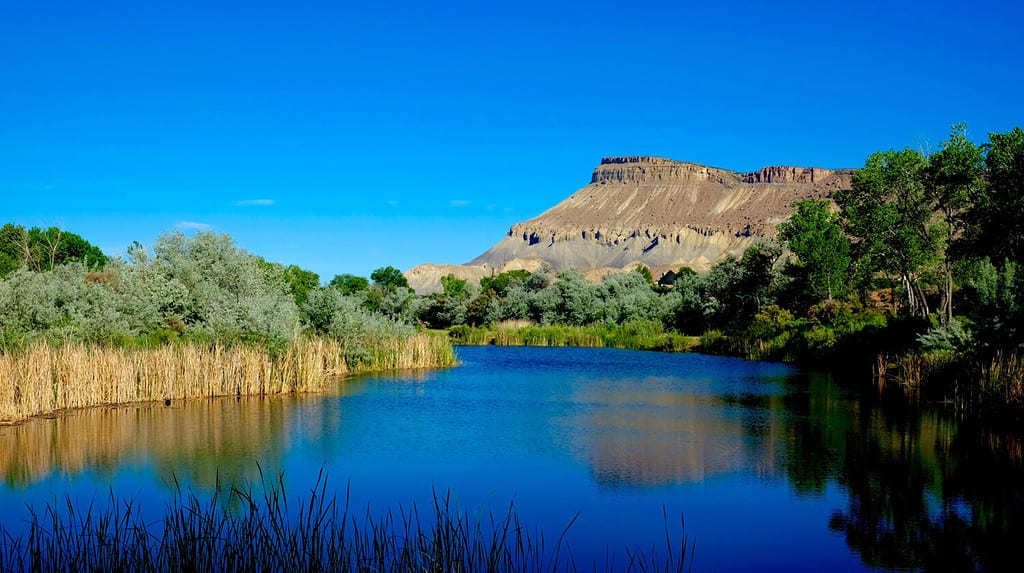
Various snake species find their habitat in the rivers and water bodies of Colorado.
©Jane Y/Shutterstock.com
Each unique snake species in Colorado contributes to the vibrant and captivating snake population within the state. This article aims to delve into the various snake species you might encounter when exploring three of Colorado’s major rivers and their attractions:
- The Snake River
- The Colorado River
- The Arkansas River
| River Name | River Fact |
|---|---|
| 1. The Snake River (1,040 miles) | The Snake River in Colorado is home to a large number of species, including both native and introduced fish. The Snake River is known for its high concentration of brown trout, which are native to the region. Other species that inhabit the river include rainbow trout, cutthroat trout, white bass, walleye and northern pike. |
| 2. The Colorado River (1,450 miles) | The Colorado River, a prominent waterway in the Western United States, meanders through the states of Colorado, Utah, Arizona, California, and Nevada. Revered for its breathtaking canyons, this mighty river also plays a vital role in supplying water for irrigation and generating hydroelectric power. |
| 3. The Arkansas River (1,443 miles) | The Arkansas River, stretching as the sixth-longest river in the United States, gracefully winds its way through the states of Colorado, Kansas, Oklahoma, and Arkansas. Renowned for both its meandering path and its vital role in navigation and agriculture, this majestic river holds paramount significance. |
#1 – The Snake River
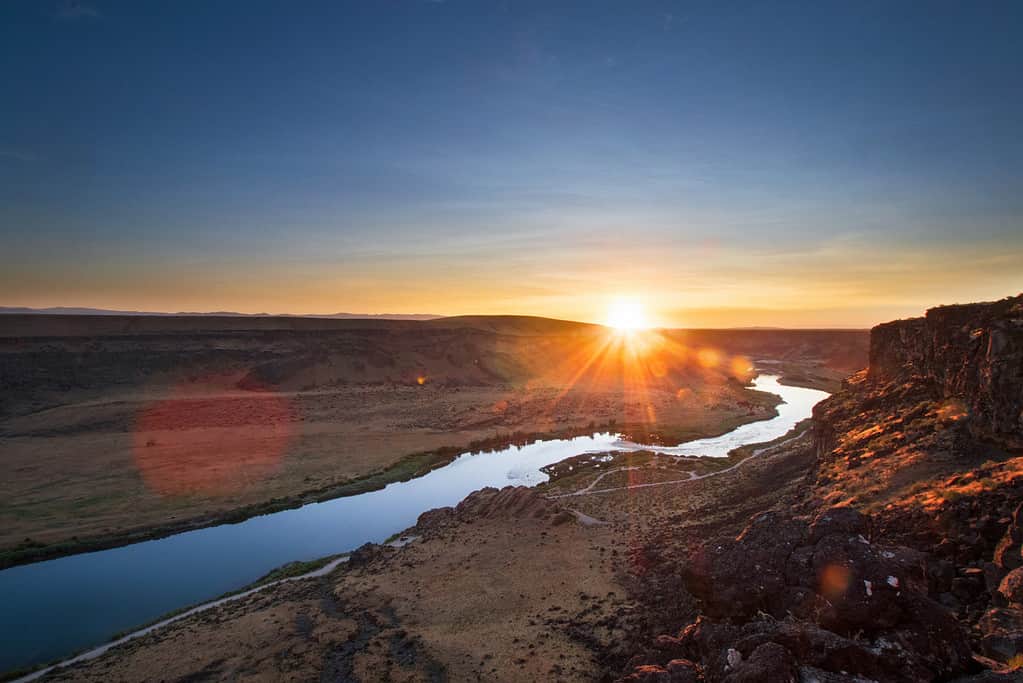
Witness the breathtaking beauty of a mesmerizing sunset cascading over the serpentine river in Idaho.
©graphicphoto/iStock via Getty Images
The Snake River derives its name from the Snake Indians, whose lands the river largely traverses. This captivating river attracts numerous visitors for activities such as fishing, rafting, and camping. It boasts a diverse range of wildlife, including fish, birds, mammals, and reptiles. Located in western Colorado, the Snake River winds its way through areas teeming with prairie rattlesnakes, the most prevalent venomous snake in the state. Stretching approximately 75 miles (121 km), this majestic river originates in the Rocky Mountains before gracefully meandering westward across the Colorado Plateau. Eventually, it converges with the Green River near the town of Rifle.
Common Snakes of the Snake River
The Snake River in Colorado is home to a variety of snakes, including several non-venomous species. These snakes play an important role in the ecosystem by helping to control rodent populations. Some of the common snakes found on the Snake River include the following:
Bullsnake (Pituophis catenifer)
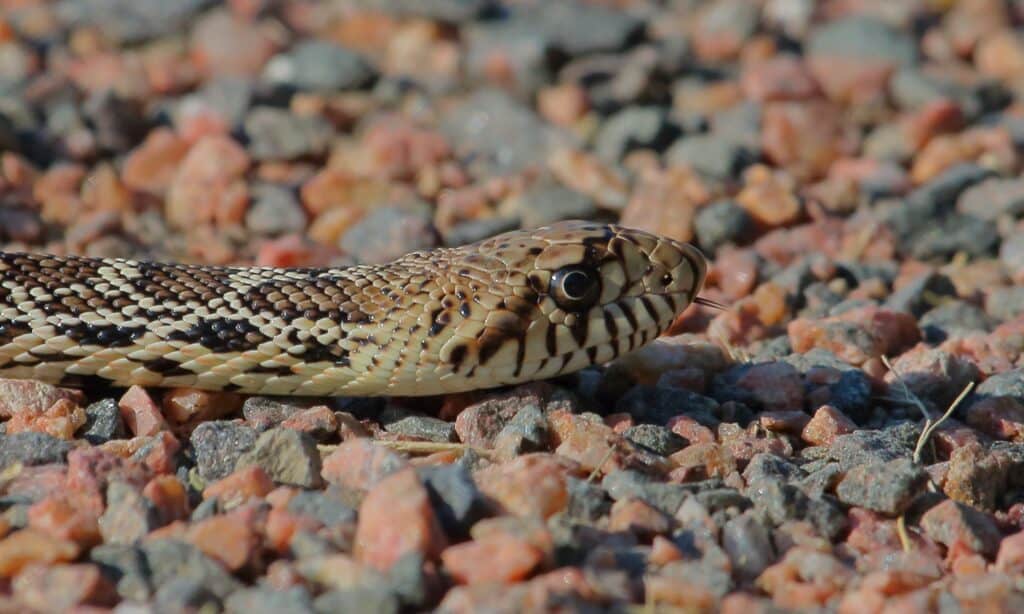
Bullsnakes are found throughout Colorado except in high-altitude regions of the Rocky Mountains.
©iStock.com/tami1120
The bullsnake, mistakenly sometimes called a gopher snake, is one of the largest snakes living in Colorado. It is a non-venomous constrictor that is typically 4 to 6 feet long. However, some individuals can grow up to 8 feet! Bullsnakes are heavy-bodied snakes, with most being between 2 to 3 pounds. Bullsnakes are found throughout Colorado except for high in the Rocky Mountains. They live in grasslands, woodlands, and on farms. Farmers actually don’t mind these large snakes because they eat mice, moles, and rabbits. You can also find bullsnakes in residential areas, especially the yards of homes that border grasslands.
Northern Watersnake (Nerodia sipedon)
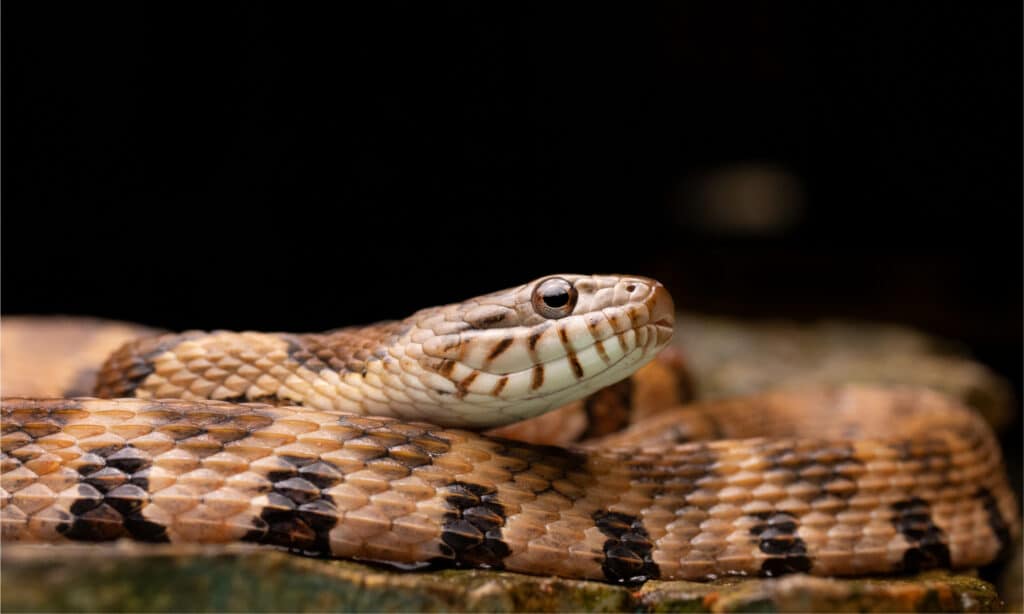
Northern watersnakes are beautiful reptiles that can be spotted at elevations below 5,500 feet.
©Radiant Reptilia/Shutterstock.com
The northern watersnake is one of the only water snake species found in Colorado (if not the sole species). It inhabits the eastern half of the state, mostly around the South Platte, Arkansas, and Republican Rivers. With a body length averaging 3 to 4 feet, they possess a stout physique, featuring a broad head and a long tail. Northern watersnakes are active both day and night, but their peak activity occurs at dawn and dusk. They rely on basking in the sun as a means of regulating their body temperature. During the winter months, typically from November to March, these snakes enter a dormant state similar to hibernation.
Blackneck Garter Snake (Thamnophis cyrtopsis)
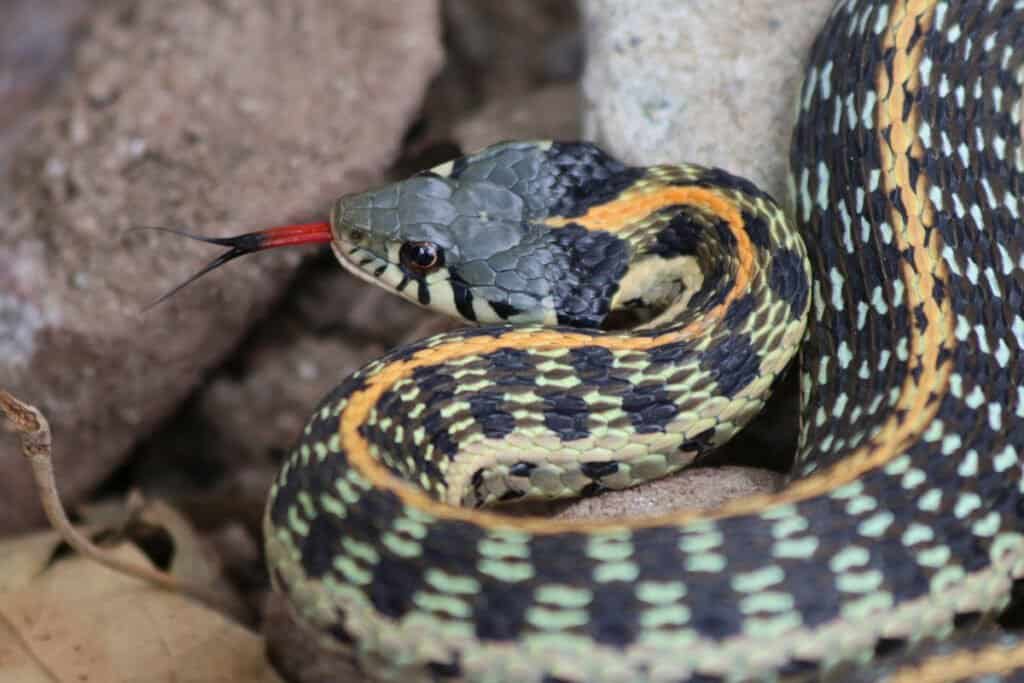
Blackneck garter snakes feed mainly upon small fish, frogs, lizards,
earthworms
, mollusks and insects.
©Creeping Things/Shutterstock.com
The blackneck garter snake is a common snake species found throughout Colorado, primarily in the western and southern regions. These non-venomous snakes have a fascinating reproductive behavior — they give birth to live young. During the summer months, a litter of 10 to 20 baby snakes is usually born. With an average length of less than 24 inches, the blackneck garter snake has a slender body and a distinguishable black or dark brown head and neck. You can spot these snakes in a variety of habitats, including meadows, marshes, and streams, where they often bask in the sun on rocks or logs. As adaptable eaters, blackneck garter snakes opportunistically prey on a wide range of food sources, such as frogs, salamanders, fish, and earthworms.
#2 – The Colorado River

Renowned as a prominent waterway in the American Southwest and northern Mexico, the Colorado River stretches an impressive 1,450 miles (2,330 km).
©Jane Y/Shutterstock.com
Originating in the central Colorado Rocky Mountains at the Continental Divide, the Colorado River courses its way southwestward across the Colorado Plateau. Majestically flowing through the iconic scenery of the Grand Canyon, it eventually reaches Lake Mead along the Arizona-Nevada border before gradually veering southward toward the international boundary. Embracing its role as a major drainage system, it encompasses vast expanses of arid terrain that traverse seven states in the United States and two states in Mexico. Remarkably, in contrast to its captivating journey, the Colorado River meanders through regions that are relatively less populated by the enigmatic rattlesnake.
Common Snakes of the Colorado River
The Colorado River in Colorado is home to a rich variety of harmless snakes. These non-venomous serpents are typically found along the riverbanks and in moisture-rich habitats such as wetlands and ponds. They play a crucial role in their ecosystems by effectively regulating rodent populations.
Great Basin Gopher Snake (Pituophis catenifer deserticola)
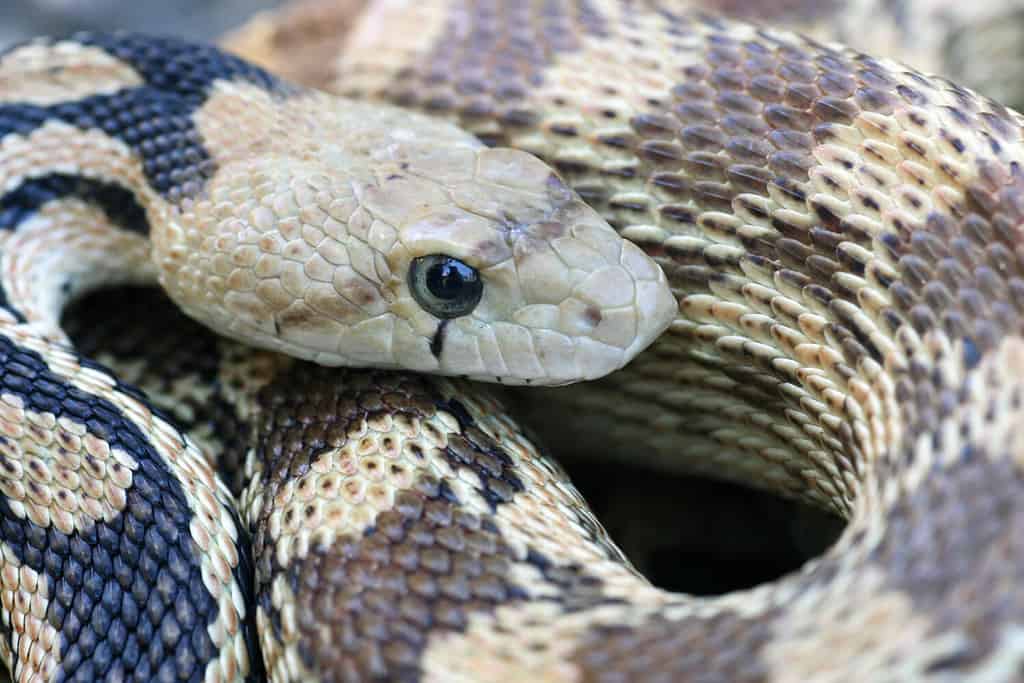
The Great Basin gopher snake is muscular and strikes with its mouth closed.
©Michael Benard/Shutterstock.com
Great Basin gopher snakes are particularly common in and near the Colorado River. These non-venomous reptiles are harmless to humans, with bodies adorned with orange-brown, yellow, tan, or cream and rows of large square blotches. Near the end of the body, the blotches are reddish-brown or black. Great Basin gopher snakes are typically 3 to 4 feet long, but some can grow up to 6 feet in length. They are skilled at hiding, and commonly swim rivers and climb trees.
Common Garter Snake (Thamnophis sirtalis)

Common garter snakes live in a wide variety of habitats, such as riparian areas, woodlands, grasslands, and rivers.
©iStock.com/rkhalil
The common garter snake is the most common snake living in Colorado. It is non-venomous and grows 2 to 3 feet in length with a slim olive-green or brown body. Yellow, cream, or orange strings run along the snake’s back and sides. Common garter snakes are mostly active during the day and are generalist feeders, eating a variety of toads, frogs, salamanders, earthworms, fish, slugs, small birds, and rodents
Striped Whipsnake (Masticophis taeniatus)
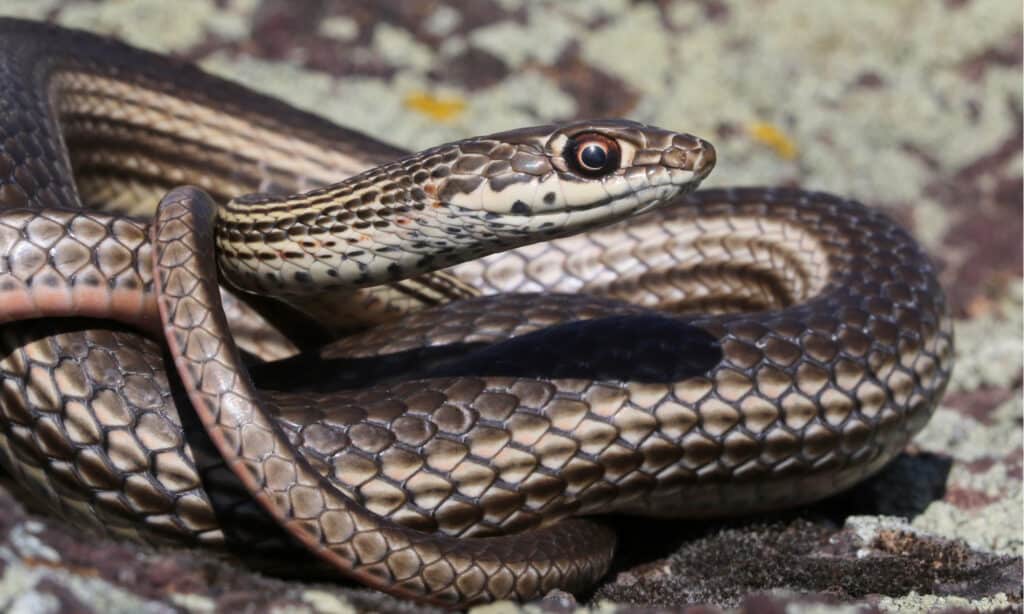
Striped whipsnakes have quick, slender bodies that typically grow 3 to 4 feet in length.
©Randy Bjorklund/Shutterstock.com
The striped whipsnake inhabits the southern regions of the United States including Colorado. With its sleek and elongated physique, adorned by a striking black and white pattern tracing the length of its back, this species thrives in arid and open landscapes, including deserts and scrubland. As a nocturnal creature, the striped whipsnake sustains its livelihood through a diet primarily comprised of small rodents, lizards, birds, and their eggs.
#3 – The Arkansas River
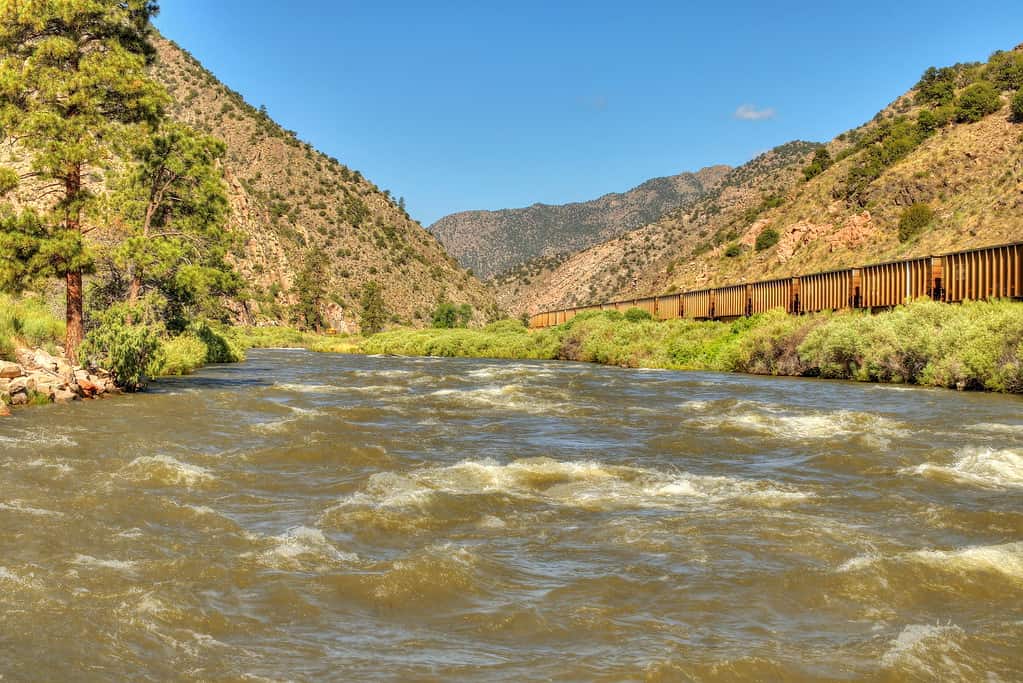
Renowned for its beauty, the river offers outdoor pursuits like whitewater rafting, fishing, and camping.
©Hundley_Photography/ via Getty Images
Flowing 1,469 miles through the majestic Rocky Mountains in central Colorado, the Arkansas River is a beloved waterway in the state. It also serves as a vital water source for irrigation and drinking. As the second-longest tributary in the Mississippi-Missouri River system, it traverses four states, divided into three distinct sections. From the Rocky Mountains, the upper portion descends rapidly, creating thrilling whitewater rafting. It carves through the Royal Gorge before meandering through Colorado, Kansas, and Oklahoma. In eastern Oklahoma, it transitions into the lower portion, continuing eastward into Arkansas and eventually merging with the mighty Mississippi River.
Common Snakes of the Arkansas River
It is essential to exercise caution and respect when exploring snake habitats in Colorado, prioritizing the safety and well-being of both humans and wildlife. The Arkansas River in Colorado is home to several snake species, and it’s important to note that not all of them are aquatic. Here are some of the most common snake species found in or around the Arkansas River in Colorado:
Western Terrestrial Garter Snake (Thamnophis elegans)
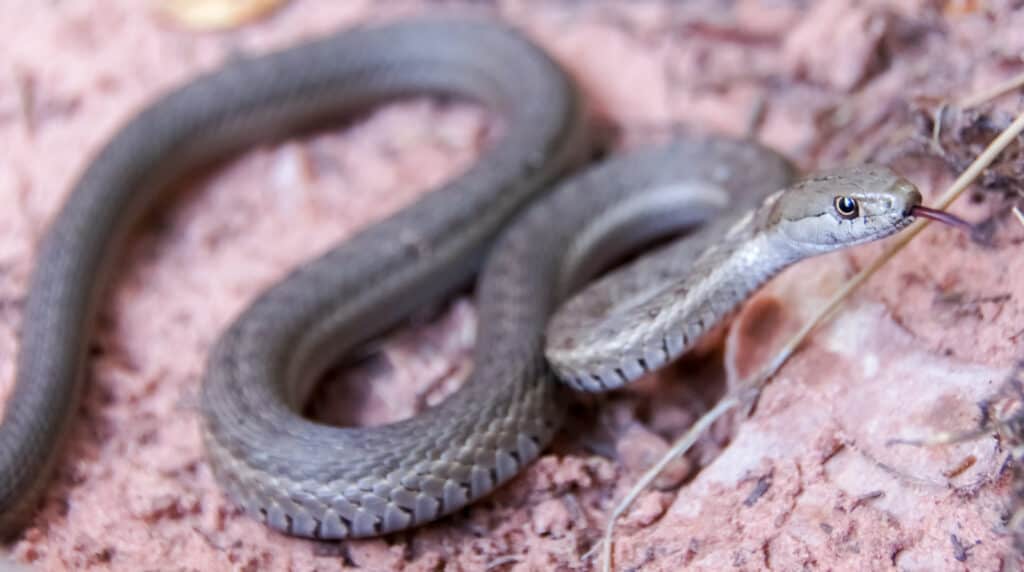
Western terrestrial garter snakes can take on defensive posturing and potentially bite, but they are not venomous.
©iStock.com/yhelfman
The western terrestrial garter snake is one of the most common snakes in Colorado. It especially spends much of its time in or near water, swimming or basking on rocks. This slender reptile is not venomous and grows around 20 to 30 inches in length. Its body is olive-green or brown, adorned with three lighter-colored stripes on its backs and sides. The western terrestrial garter snake is harmless to humans and eats a wide variety of small animals, such as lizards, amphibians, and rodents.
Western Hognose Snake (Heterodon nasicus)
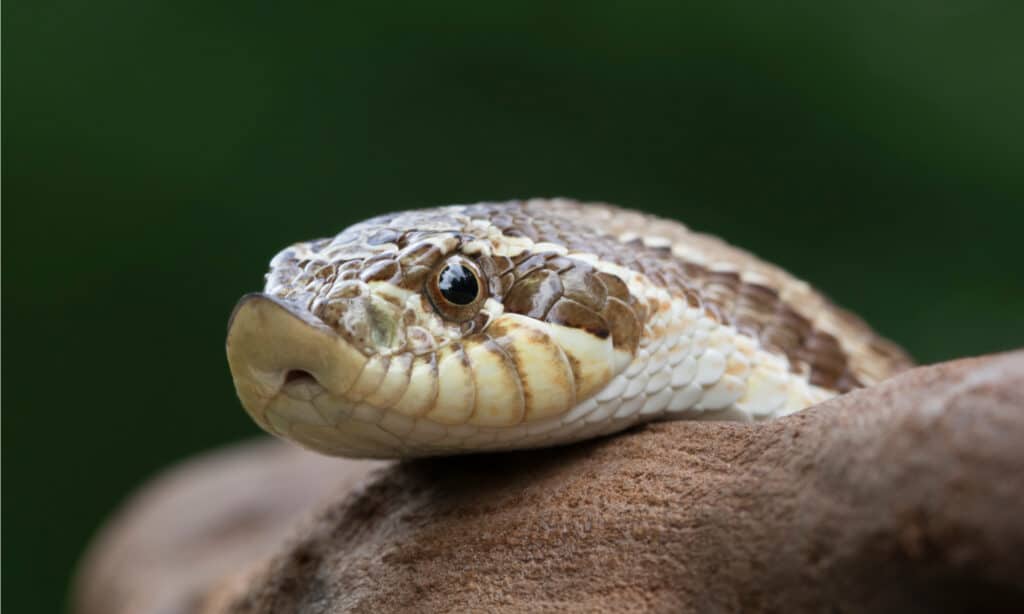
The western hognose snake has a strongly upturned, pointed snout.
©Mark_Kostich/Shutterstock.com
The western hognose snake, a captivating species belonging to the family Colubridae, can be found in various regions in North America. From southern Canada to the northern parts of Mexico, this snake shows a preference for sandy or gravelly soils, thriving in river floodplains, scrub prairies, semi-deserts, grasslands, and even certain semi-agricultural areas.
Western Yellow-Bellied Racer (Coluber constrictor mormon)
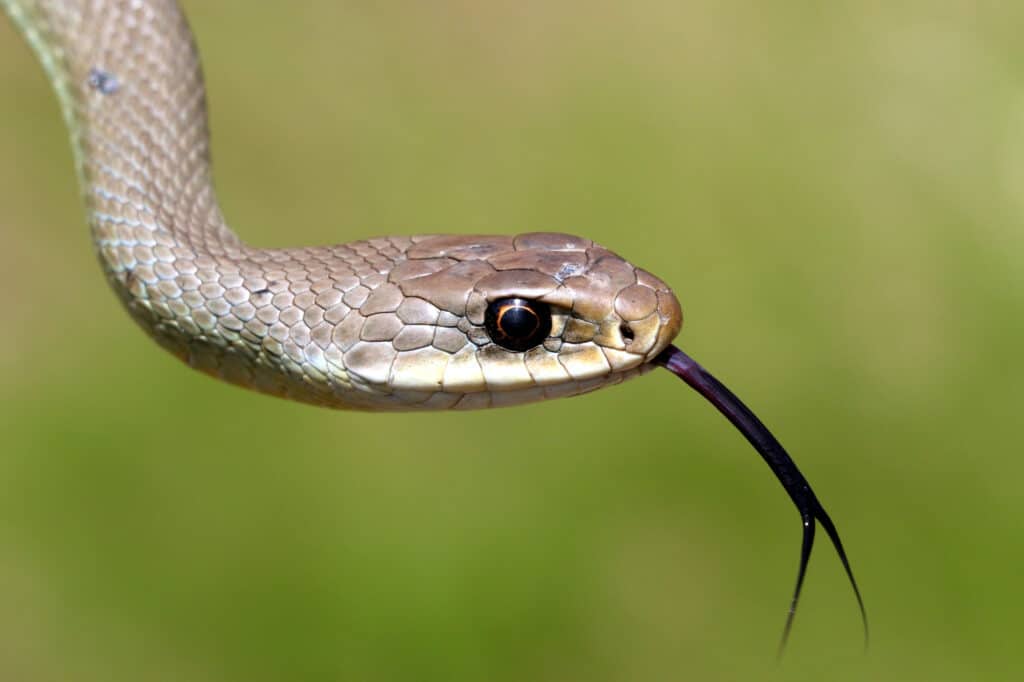
The versatile Mormon racer exhibits an opportunistic diet and even eats rattlesnakes.
©iStock.com/randimal
The western yellow-bellied racer is a non-venomous snake that is not dangerous to humans. It is a subspecies of the eastern racer. Also known as the Mormon racer, it is a non-venomous snake native to the western United States. It is a medium-sized snake, typically growing to lengths of 2 to 4 feet. The Mormon racer has a slender body and a long tail. Its scales are smooth and shiny, and its coloration varies from brown to gray to olive green. Racer snakes, known for their incredible speed, can reach velocities of up to 3.5 miles per hour as they maneuver both on the ground and through foliage. Although they prefer to flee rather than confront, caution is necessary when attempting to handle them, as they can deliver a bite.
Four Venomous Rattlesnakes to Watch For in Colorado’s Rivers
Rattlesnakes derive their name from the distinctive rattle positioned on their tail’s end. Composed of hollow, interlocking segments formed by modified scales, this unique appendage creates a resounding rattling sound when the snake vibrates its tail. Functioning as a warning to potential predators, the snake employs its rattle to convey danger. When threatened, the rattlesnake adeptly signals its perilous nature by producing rhythmic vibrations.
In addition to the non-venomous snakes listed above, there are four venomous rattlesnakes that live in and around rivers in Colorado:
- Prairie rattlesnake
- Western massasauga rattlesnake
- Desert massasauga rattlesnake
- Midget faded rattlesnake
Prairie Rattlesnake (Crotalus viridis)

Prairie rattlesnakes are venomous but they aren’t aggressive, so if you see one, leave it alone and give it a wide berth.
©iStock.com/Matt Kaminski
The prairie rattlesnake reigns as one of Colorado’s most prevalent (if not the most prevalent) venomous snakes. It is also the largest species of rattlesnake in the state. This adaptable species thrives in a diverse range of habitats, from grasslands to forests and foothills. Sporting an elegant yet ominous appearance, the prairie rattlesnake measures approximately 2 to 3 feet in length and displays a coloration of gray or brown adorned with distinctive dark blotches. This formidable creature possesses a rattle at the tail’s terminus, which serves as an effective warning signal against potential predators. The prairie rattlesnake is diurnal, meaning it is active both day and night, particularly during the summer months. It preys on small mammals like rodents, rabbits, and lizards.
Western Massasauga Rattlesnake (Sistrurus catenatus tergeminus)

The venom of the western massasauga rattlesnake is potent and can prove fatal to humans.
©Vladislav T. Jirousek/Shutterstock.com
The western massasauga rattlesnake is a small venomous pit viper native to southeastern Colorado. It measures around 18 to 24 inches in length and features a gray or brown body adorned with dark bands. Unlike other rattlesnake species, it lacks a rattle but can create a buzzing sound by vibrating its tail. This elusive creature inhabits sandy or gravelly areas, including prairies, meadows, and marshes. Employing an ambush strategy, it patiently awaits its prey, primarily targeting rodents and small mammals within striking range. While generally reserved and non-confrontational, it will bite if it feels threatened. Unfortunately, this magnificent species is considered threatened in Colorado, primarily due to habitat loss, fragmentation, and incidents involving road mortality.
Desert Massasauga Rattlesnake (Sistrurus tergeminus edwardsii)
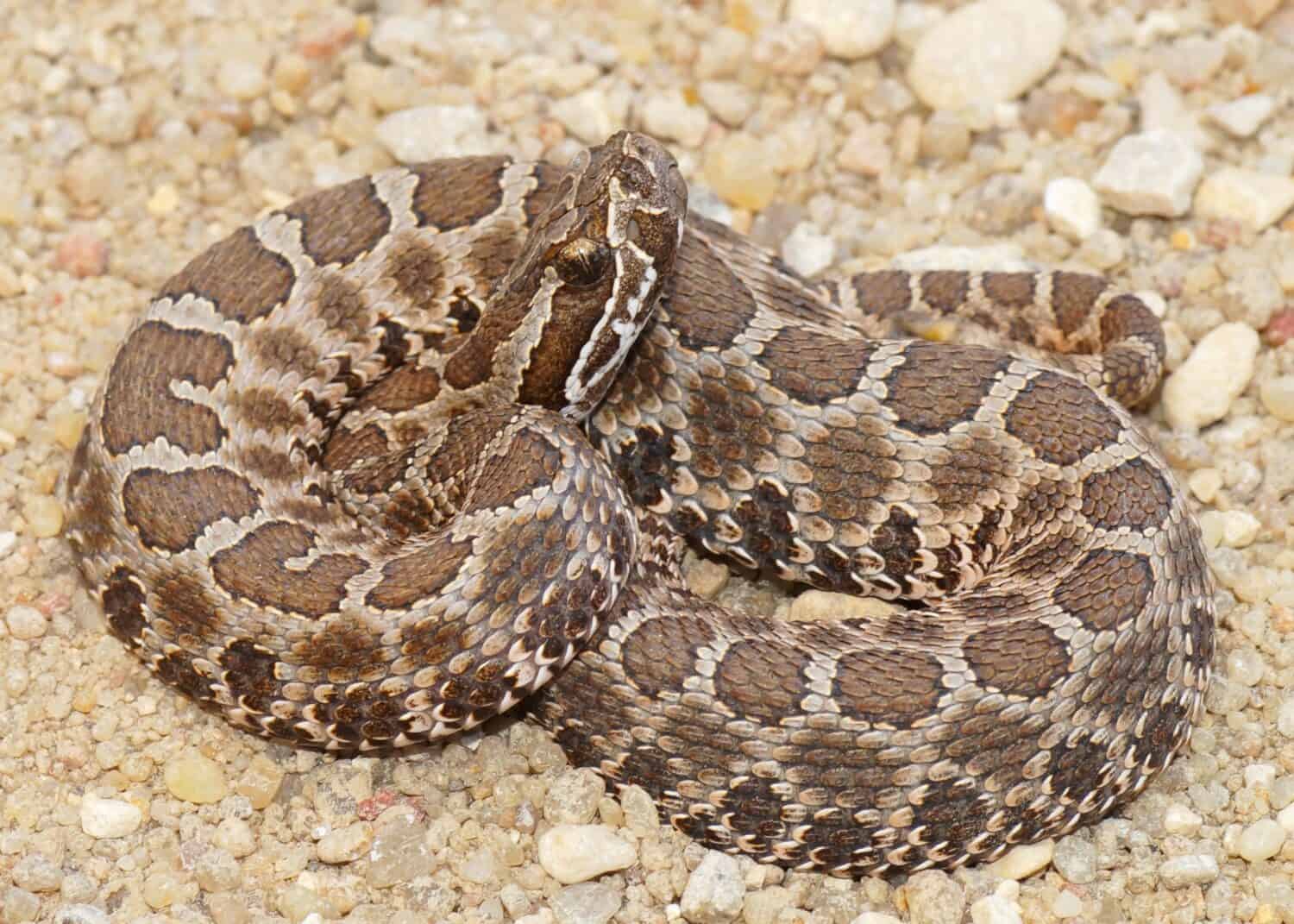
Desert massasauga rattlesnakes are endemic to the southwestern United States and northern Mexico.
©Matt Jeppson/Shutterstock.com
There are distinct differences between the desert massasauga rattlesnake and the western massasauga rattlesnake. While both belong to the massasauga rattlesnake subspecies, their habitats and physical characteristics set them apart. The desert massasauga rattlesnake thrives in xeric prairie habitats spanning from western Texas to southeastern Arizona, with scattered populations in Colorado and Mexico. It is a medium-sized pit viper, measuring less than 25 inches. The desert massasauga rattlesnake generally exhibits a slightly smaller body size in comparison to its counterpart, the western massasauga rattlesnake. Furthermore, their distinct behavioral and appearance characteristics warrant their classification as separate subspecies of the massasauga rattlesnake.
| Species: The Massasauga Rattlesnake | Description |
|---|---|
| Subspecies: Desert Massasauga Rattlesnake (Sistrurus tergeminus edwardsii) | Colorado is where both the desert massasauga rattlesnake and the western massasauga rattlesnake call home. The southeastern part of the state hosts the desert massasauga rattlesnake, while the northeastern part is inhabited by the western massasauga rattlesnake. |
| Subspecies: Western Massasauga Rattlesnake (Sistrurus tergeminus tergeminus) | While the desert massasauga rattlesnake is more prevalent in Colorado, the western massasauga rattlesnake holds lesser frequency. Although not classified as threatened or endangered within the state unlike the desert massasauga rattlesnake, it remains crucial to safeguard its habitat and refrain from disturbing this remarkable serpent. |
Midget Faded Rattlesnake (Sistrurus miliarius barbouri)
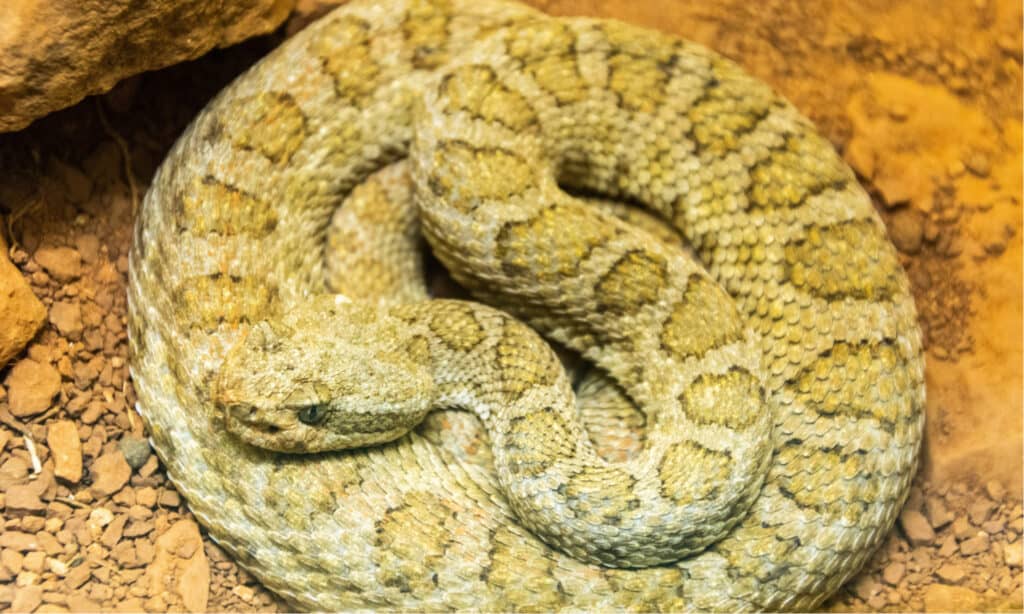
This species has a couple of nasty toxins, including one that attacks the nervous system and one that attacks muscle tissue.
©Alizada Studios/Shutterstock.com
The midget faded rattlesnake holds the distinction of being Colorado’s smallest venomous snake. Measuring just 12 to 18 inches long, it sports a gray or brown body adorned with dark blotches. Interestingly, it lacks the characteristic rattle. This elusive snake can be found in the southwestern region of Colorado, specifically in the Colorado and Green River Basins. It seeks refuge in rocky hillsides, cliff faces and slopes abundant with crevices, rock cover, and sage-brush thickets. A solitary creature, the midget faded rattlesnake is active during the day and sustains itself on small mammals, lizards, and frogs. While its venom is not as potent as that of other rattlesnakes, a bite from this snake can still pose a danger. Notably, the Colorado Department of Natural Resources has classified the midget faded rattlesnake as a Species of Concern.
Summary of the Most Snake-Infested Rivers in Colorado
| Snakes in Colorado’s Rivers | Scientific Name | Venomous |
|---|---|---|
| Bullsnake | Pituophis catenifer | No |
| Northern watersnake | Nerodia sipedon | No |
| Blackneck garter snake | Thamnophis radix | No |
| Great Basin gopher snake | Pituophis catenifer deserticola | No |
| Common garter snake | Thamnophis sirtalis | No |
| Striped whipsnake | Masticophis taeniatus | No |
| Western terrestrial garter snake | Thamnophis elegans | No |
| Western hognose snake | Heterodon nasicus | No |
| Western yellow-bellied racer | Coluber constrictor mormon | No |
| Prairie rattlesnake | Crotalus viridis | Yes |
| Western massasauga rattlesnake | Sistrurus catenatus | Yes |
| Desert massasauga rattlesnake | Sistrurus tergeminus edwardsii | Yes |
| Midget faded rattlesnake | Sistrurus miliarius barbouri | Yes |
The photo featured at the top of this post is © iStock.com/Matt Kaminski
Discover the "Monster" Snake 5X Bigger than an Anaconda
Every day A-Z Animals sends out some of the most incredible facts in the world from our free newsletter. Want to discover the 10 most beautiful snakes in the world, a "snake island" where you're never more than 3 feet from danger, or a "monster" snake 5X larger than an anaconda? Then sign up right now and you'll start receiving our daily newsletter absolutely free.
Thank you for reading! Have some feedback for us? Contact the AZ Animals editorial team.






